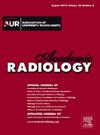两全其美:利用光子计数探测器 CT 诊断急性肺栓塞的超高间距肺血管造影与自由呼吸技术。
IF 3.8
2区 医学
Q1 RADIOLOGY, NUCLEAR MEDICINE & MEDICAL IMAGING
引用次数: 0
摘要
原理和目的:与匹配的基于能量积分探测器(EID)的单能量 CTPA 相比,评估使用光子计数探测器(PCD)CT 以自由呼吸技术诊断肺栓塞的超高分辨率 CT 肺血管造影(CTPA)的图像质量和辐射剂量:对51例PCD-CTPA与51例第三代双源EID-CT上的CTPA进行了前瞻性比较。CTPA 采用超高间距方案和自由呼吸技术(40 mL 造影剂,间距 3.2),在 140 kV(PCD)和 70-100 kV(EID)下采集。碘图由光谱 PCD-CTPA 重建。CTPA 和碘图的图像质量由三名放射科医生独立评估。此外,还比较了肺动脉内的 CT 衰减数以及信噪比和对比信噪比(SNR、CNR)。比较了放射剂量:结果:PCD 组的 CT 衰减更高(P<0.05)。在 PCD-CTPA 中,肺叶肺动脉的 CNR 和 SNR 较高(P < 0.05),而肺动脉干内则无差异(P > 0.05)。PCD-CTPA的图像质量被所有读者评为最佳(96.1%的PCD-CTPA与50.9%的EID-CTPA相比,图像质量为优/良)。PCD-CT 没有产生非诊断性扫描结果,而 EID-CTPA 有 3 次非诊断性扫描(5.9%)。PCD-CT 的辐射剂量低于 EID-CT(有效剂量为 1.33 ± 0.47 mSv vs. 1.80 ± 0.82 mSv;均为 P 结论:PCD-CT 的辐射剂量低于 EID-CT(有效剂量为 1.33 ± 0.47 mSv vs. 1.80 ± 0.82 mSv):采用自由呼吸技术的超高螺距 CTPA 与 PCD-CT 可在显著降低辐射剂量和获得完整光谱信息的情况下获得卓越的图像质量。使用超高螺距 CTPA 时,只有 PCD-CTPA 能够重建包含额外功能信息的碘图。本文章由计算机程序翻译,如有差异,请以英文原文为准。
The Best of Both Worlds: Ultra-high-pitch Pulmonary Angiography with Free-Breathing Technique by Means of Photon-Counting Detector CT for Diagnosis of Acute Pulmonary Embolism
Rationale and Objectives
To assess image quality and radiation dose of ultra-high-pitch CT pulmonary angiography (CTPA) with free-breathing technique for diagnosis of pulmonary embolism using a photon-counting detector (PCD) CT compared to matched energy-integrating detector (EID)-based single-energy CTPA.
Materials and Methods
Fifty-one PCD-CTPAs were prospectively compared to 51 CTPAs on a third-generation dual-source EID-CT. CTPAs were acquired with an ultra-high-pitch protocol with free-breathing technique (40 mL contrast medium, pitch 3.2) at 140 kV (PCD) and 70–100 kV (EID). Iodine maps were reconstructed from spectral PCD-CTPAs. Image quality of CTPAs and iodine maps was assessed independently by three radiologists. Additionally, CT attenuation numbers within pulmonary arteries as well as signal-to-noise and contrast-to-noise ratios (SNR, CNR) were compared. Administered radiation dose was compared.
Results
CT attenuation was higher in the PCD-group (all P < 0.05). CNR and SNR were higher in lobar pulmonary arteries in PCD-CTPAs (P < 0.05), whereas no difference was ascertained within the pulmonary trunk (P > 0.05). Image quality of PCD-CTPA was rated best by all readers (excellent/good image quality in 96.1% of PCD-CTPAs vs. 50.9% of EID-CTPAs). PCD-CT produced no non-diagnostic scans vs. three non-diagnostic (5.9%) EID-CTPAs. Radiation dose was lower with PCD-CT than with EID-CT (effective dose 1.33 ± 0.47 vs. 1.80 ± 0.82 mSv; all P < 0.05).
Conclusion
Ultra-high-pitch CTPA with free-breathing technique with PCD-CT allows for superior image quality with significantly reduced radiation dose and full spectral information. With the ultra-high pitch, only PCD-CTPA enables reconstruction of iodine maps containing additional functional information.
求助全文
通过发布文献求助,成功后即可免费获取论文全文。
去求助
来源期刊

Academic Radiology
医学-核医学
CiteScore
7.60
自引率
10.40%
发文量
432
审稿时长
18 days
期刊介绍:
Academic Radiology publishes original reports of clinical and laboratory investigations in diagnostic imaging, the diagnostic use of radioactive isotopes, computed tomography, positron emission tomography, magnetic resonance imaging, ultrasound, digital subtraction angiography, image-guided interventions and related techniques. It also includes brief technical reports describing original observations, techniques, and instrumental developments; state-of-the-art reports on clinical issues, new technology and other topics of current medical importance; meta-analyses; scientific studies and opinions on radiologic education; and letters to the Editor.
 求助内容:
求助内容: 应助结果提醒方式:
应助结果提醒方式:


